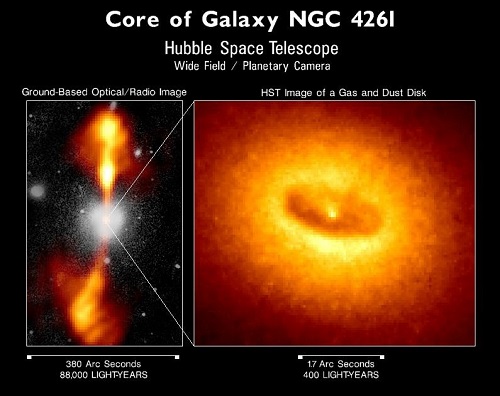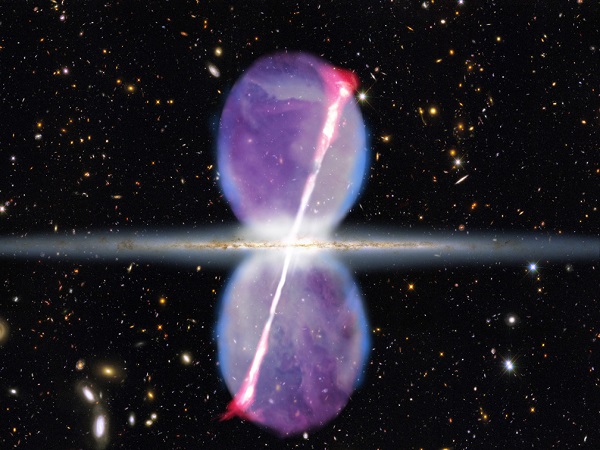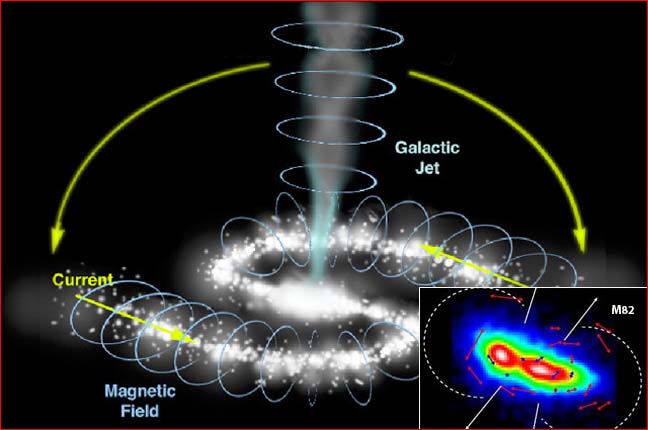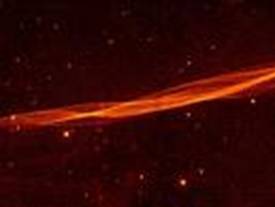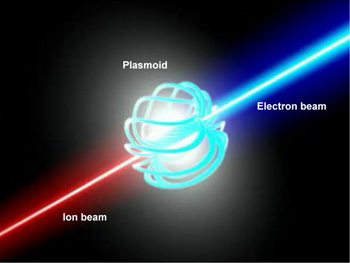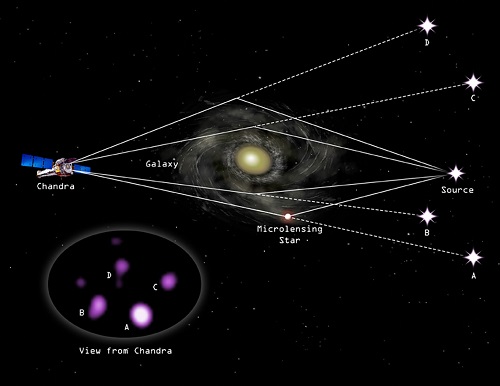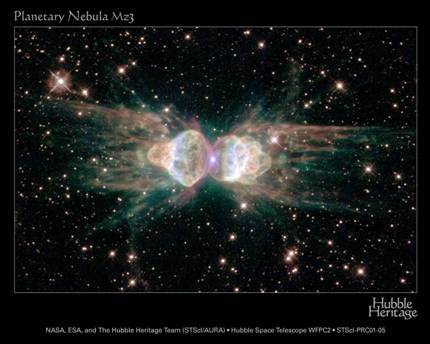Explanations and Interpretations: Galaxy Cores and Galaxy Formation
Cores: As mentioned in the page on Galaxies, there are two main theories regarding galaxy cores: gravitational and electromagnetic. The older explanation, and the one taught in texts and schools, is the gravitational model. In this model, the center of every galaxy is a black hole -- an area of intense gravitational pull due to a very small, massive object at the center. A black hole is said to suck in everything, including light. Behaving somewhat like a whirlpool, a black hole causes anything near it to circle faster and faster until it is finally sucked in and disappears. The only way the gravitational model can account for the brilliance we see in quasars is to theorize that the black hole would be responsible for an accretion disk around it which would give off the light due to the speed of its movement around the central object. NASA's page on Black Holes is probably the best lay explanation around. That being said, it must be stated first, and bluntly, that we don't think black holes exist. If not even light can get out, how is it the cores of galaxies are shooting out massive amounts of x-rays and material?
Electromagnetic Solution: There are a number of clues that lead to an electromagnetic explanation rather than the old gravitational explanation. 1. Distant cores of galaxies have already been identified as quasars. The closer you get to our galaxy, and thus the more recent in time, the dimmer the quasars become. However they still discharge x-ray and gamma ray bursts, just as the center of our galaxy does. Thus, the indication is not of black holes in galaxy centers, but of dimming quasars, or quasars with a dimming central engine.
2. The magnetic field associated with the central engine has just been shown to be extremely intense. (They are still trying to make it fit with the concept of black holes). Magnetic fields can only be caused by electric currents. Thus there must be a very strong electric current associated with this magnetic field. Electromagnetism can be up to 1039 times as strong as gravity in space. The electric current in this case would be about 1020 amps. As Peratt mentions in his book, Physics of the Plasma Universe, this is the expected strength of electric current necessary for the core of a galaxy if the galaxy is produced by plasma processes. 3. Peratt and others have shown how the electric current flows in a galaxy to cause these magnetic fields, and how they come to a focus at the galaxy core.
It is the M82 Galaxy which gave us this information. 4. We know the jets on quasars are plasma, moving at speeds close to the speed of light. We can see this with the use of spectroscopes. We know that plasma in motion is an electric current and thus produces a magnetic field. We also know that the vast majority -- 99% -- of the material universe is plasma. We can see plasma filaments throughout space, as shown in the first picture below, and, in the second picture, we can see how they interact in the lab, forming miniature galaxies in a matter of seconds.
5. When electric and magnetic fields become concentrated, as they do at the center of a galaxy, they form a plasmoid. A plasmoid is a rotating sphere of plasma with intense electric and magnetic fields which shoots off jets of plasma from its poles, one side positive and the other side negative. These jets are an intrinsic part of a plasmoid, but are impossible to get from a black hole. The plasmoid in the centers of galaxies must be about 200 AU across. This is extraordinarily small, astronomically speaking, about five times the distance from the sun to Pluto.
A plasmoid such as this has the energy to produce the very bright lights and energetic jets we see from distant quasars. Problems with the gravitational model: 1. The gravitational model was only proposed because no one was considering any alternative at the time, and every effort has been made to cram data into it, regardless of data fit.
2. It is impossible for material from the accretion disk to spiral into a black hole and then produce jets of plasma. 3. If the black hole were there, you should see gravitational lensing of light around it, but we don't. Gravitational lensing results in multiple images of an object behind a black hole due to the intense gravitational field acting in the same way as the lens of a magnifying glass. We do see gravitational lensing around entire galaxies and galaxy clusters, as illustrated below.
While this form of lensing can be seen around an entire galaxy (and galaxy clusters), as illustrated above, it does not happen around the quasars in the nucleus. We have looked for gravitational lensing of stars that rapidly circle what is thought to be the super massive black hole in the center of our Milky Way Galaxy. We have searched for over fifteen years for such lensing, and none has ever been found. 4. In November, 2014, a gas cloud labeled G2 was seen to approach what was thought to be the Milky Way's black hole. It was expected that this gas cloud would have been gobbled up by the black hole. That did not happen. Instead, it orbited around it and then continued outward on its elliptical orbit. Gravitational astronomers have been trying to explain this. Some say it wasn't a gas cloud at all, but a binary star going around the black hole. However the evidence is pretty conclusive that it was a gas cloud. (Even a binary star should have shown some reaction to its proximity to the supposed black hole) We can see from spectral lines that the material close to the core of a galaxy is rotating around it extremely rapidly. The gravitational model expects this from the whirlpool effect a black hole would produce. The elliptical orbits of stars around the core can also be used to support the black hole model. The plasma model also expects this phenomena. While there is some gravitational attraction coming from the central engine, the speed of the orbiting material would be dependent upon the strength of the electromagnetic field involved. The higher the electric current, the faster the spin rate. The elliptically orbiting stars would also be highly influenced by the electrical attraction between the plasmoid and the star. In other words, both models are quite comfortable with the rapid spin rate close to the core of a galaxy. When two peculiar galaxies are interacting, very often a stream of material between them is seen. This stream is referred to as a bridge.
In addition to the bridge between them, there are often tails of material extending away from either or both of the galaxies, as can be seen with the lower galaxy in the photograph. According to gravitational astronomy, these bridges must have taken millions of years to form as the two galaxies slowly separated. The tails are a little bit more difficult to account for, because they are moving in a direction against the gravitational attraction. Some astronomers use the evidence of the bridges between galaxies to prove the universe is very old. However, plasma physics offers a different explanation. Because galaxies, and the filaments associated with them, are electromagnetic in character, the strong electric and magnetic fields will cause the bridge to form as well as the formation of the tails. Plasma piinches in the bridges and the tails will cause stars to form very rapidly. Nor do the bridges and tails take millions of years to form as plasma acts much more rapidly than gravity does. The Big Bang model, which is the gravitational model, states that both stars and entire galaxies are the result of gravitational forces acting on clouds of gas and dust. However, there are some major problems with this model. First, supposing that gas and dust did start to accrete due to gravitation, as the particles came closer together, their heat would increase and end up driving them apart. This is simple physics. Second, in order to get gravity to be strong enough -- for it is a weak force -- those supporting this model have had to invent something they call "dark matter," which cannot be found anywhere, but which must exist in their model and make up the vast majority of matter in the universe, exerting the gravitational force that cannot exist with just the matter that is seen. A third problem exists as they try to answer the first problem -- that of increasing heat driving matter away instead of allowing it to collapse into stars or galaxies. They say that the heat being generated can be radiated away in the infrared and not affect the collapse by means of the presence of complex molecules such as carbon monoxide, carbon dioxide, etc. The problem with this is that, in their model, the early universe contained no complex molecules. It contained only hydrogen and helium. Their model requires stars to build up the heavier elements within them, which would then explode out when the star exploded. It was only after that happened that complex molecules could form. So there is no way to get their first stars to form. There is another problem which plagues the gravitational model. In the beginning, the universe was expanding so rapidly that stars and galaxies must somehow have been formed before matter had separated so far that gravitational forces could not act. This presents them with a very narrow window of time to not only get the first stars somehow formed, but also exploded, complex molecules formed, and then entire galaxies formed. The mathematics involved explaining this process are quite straight forward -- and they show it cannot happen. However, when we look at what is actually seen in outer space and correlate it with work in our labs on plasma filaments, we find rather simple explanations for both star and galaxy formation, as explained in detail on the page on the Plasma Model. Plasma filaments are notoriously unstable and can pinch and twist easily. Pinches form stars rather quickly as we can clearly see in the Bug and Ant Nebulas.
Looking down on the interaction of two plasma filaments in the lab, we can see how they start to interact with each other and quickly form a miniature galaxy:
No fancy stuff needed, no dark matter required. It is all right there in front of us. The outer arms of these tiny galaxies swing around as fast as the inner arms do. It's part of what plasma filaments do. So why hasn't it been recognized? Plasma physics was effectively started by Kristian Birkeland, a Norwegian, between 1900 and 1920. He was studying the auroras and realized they were effects of an electric current from the sun on plasma in our upper atmosphere. He had also been doing laboratory experiments with a plasma ball and electric and magnetic fields. He had come to some conclusions from his observations of plasma behavior. His conclusions were vigerously contested by an English physicist and mathematician Sydney Chapman. Chapman was widely respected around the world for his work. Consequently, as long as he was alive and disputing plasma physics, it was not taken seriously. Even the work of Hannes Alfven in plasma physics in the 1940 - 1960's was strongly contested by Chapman and his associates. For this reason, it was widely ignored. Chapman died in 1970. By that time, however, Chapman's theories had permeated astrophysics in universities, research and even NASA. It was only once spacecraft got out beyond Earth's orbit and nearer other planets that it was realized that Chapman's theories did not agree with astronomical reality. Birkeland and Alfven were vindicated. Plasma currents are now called Birkeland Currents. Because textbooks are chronically behind ;the times, plasma physics is still almost unknown in terms of astrophysics in university courses. A major development occurred with the experimental work of Anthony Peratt at the Los Alamos National Laboratories. In the late 1980's and early 1990's, he published definitive works regarding plasma physics and astronomy. Gradually we are now seeing the admissions of plasma effects cropping up in news articles regarding what is seen in space. If you understand that plasma is often referred to as "ionized gases," you will see the admissions are a little more subtle, but they are increasing.
|
